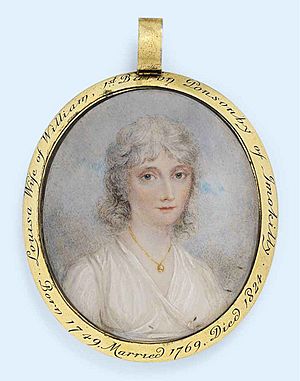William Ponsonby, 1st Baron Ponsonby facts for kids
Quick facts for kids
William Brabazon Ponsonby
|
|
|---|---|
| Baron Ponsonby of Imokilly | |

William, 1st Lord Ponsonby of Imokilly
c. 1795, by Thomas Lawrence |
|
| Tenure | 1806 |
| Born | William Brabazon Ponsonby 15 September 1744 Dublin, Ireland |
| Died | 6 November 1806 (aged 62) London, England |
| Offices | Joint Postmaster General of Ireland |
| Spouse(s) | Louisa Molesworth m. 1769 d. 1824 |
| Issue | John Ponsonby, 1st Viscount Ponsonby of Imokilly William Ponsonby Richard Ponsonby George Ponsonby Frederick Ponsonby Mary Grey, Countess Grey |
| Parents | John Ponsonby Elizabeth Cavendish |
| Occupation | Politician |
William Brabazon Ponsonby, 1st Baron Ponsonby (of Imokilly) (born September 15, 1744 – died November 5, 1806) was an important Irish politician. He was a member of the Irish House of Commons, which was like Ireland's parliament back then. After 1800, he became a member of the United Kingdom parliament.
William was the son of John Ponsonby, who was the Speaker of the Irish House of Commons. His mother was Lady Elizabeth Cavendish. In 1784, he became a Privy Counsellor of Ireland, which meant he advised the King. He also worked as a Joint Postmaster-General of Ireland from 1784 to 1789.
Contents
William Ponsonby's Political Journey
William Ponsonby studied at Trinity College, Cambridge. He started his political career representing Cork City in the Irish Parliament from 1764 to 1776. After that, he represented Bandonbridge until 1783.
Leading a Political Group
Ponsonby was a leader of a strong group of politicians in the Irish House of Commons. This group included between ten and fourteen members, making it the second largest in the parliament. They were part of the Whig political group.
Supporting the Prince of Wales
During a time called the "regency crisis" (1788–1789), Ponsonby supported the Prince of Wales. This went against the wishes of the Prime Minister, William Pitt the Younger. Because of this, Ponsonby lost his job at the Post Office.
After this, he became a strong supporter of Charles James Fox, another important Whig leader. William and his brother George worked to bring different Irish Whig groups together. Their main goal was to give more power back to landowning families and less to the King.
Fighting for Catholic Rights
Ponsonby also strongly believed in Catholic Emancipation. This meant giving Catholics more rights, like being able to vote and hold public office. He thought this would help keep the population loyal during a time of unrest and possible invasion.
A Brief Return to Power
In 1794, there was a chance for Ponsonby and his allies to regain power. Earl FitzWilliam became the new Lord Lieutenant of Ireland. Ponsonby was close to becoming the Irish Secretary of State.
However, in 1795, Ponsonby convinced FitzWilliam to fire John Beresford from his job. Ponsonby believed Beresford was corrupt. This caused a big political problem, and FitzWilliam was quickly removed from office. Beresford got his job back, and Ponsonby was back in opposition, which was a difficult time for him.
Opposing the Union
Ponsonby was a strong opponent of the union between Ireland and Great Britain. This act would join the two parliaments. He represented County Kilkenny from 1783 until the Act of Union took effect in 1801.
After the union, he became part of the Whig opposition in the Westminster House of Commons in London. He voted against the governments of Addington and Pitt. He continued to support the Prince of Wales and Catholic Emancipation. However, his influence began to lessen, and by 1803, his brother George had become the main leader of the Irish Whigs.
Becoming a Baron
By 1806, Fox was back in power. William Ponsonby's health was not good, so his wife pushed for him to be given a special title, called a peerage. She argued that he deserved it because he had opposed the Regency Bill and the Act of Union, and had always supported the Foxite Whigs.
Because of this, he quickly became a Baron on March 13, 1806. He was known as 'Baron Ponsonby, of Imokilly in the County of Cork'. He passed away in London on November 5, 1806, and was buried in Ireland.
What People Thought of William Ponsonby
Edmund Burke, another famous person of the time, described Ponsonby as "a manly, decided character" with a "clear and vigorous understanding." This means he was seen as strong, determined, and smart.
Ponsonby loved sports as much as politics. He was known for having "the best hunting establishment in Ireland" at Bishopscourt, his home in County Kildare. People said he lived there in a very generous and grand way. However, he could also get annoyed easily, especially if he felt his importance wasn't recognized.
William Ponsonby's Family
In 1769, William Ponsonby married Louisa Molesworth (1749–1824). She was the fourth daughter of the 3rd Viscount Molesworth. They had five sons and one daughter. Many of their children became notable people:
- John Ponsonby, 1st Viscount Ponsonby, became a diplomat.
- Hon. Sir William Ponsonby, a major-general in the army, was sadly killed at the famous Battle of Waterloo.
- Richard Ponsonby, became a bishop in different areas of Ireland.
- George Ponsonby was a Member of Parliament.
- Mary married the Prime Minister, Charles Grey, 2nd Earl Grey.
William Ponsonby's family line includes famous people like Edward Wood, 1st Earl of Halifax, Sir Alec Douglas-Home, and even Prince William of Wales.


